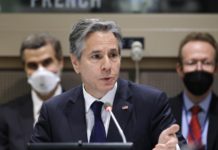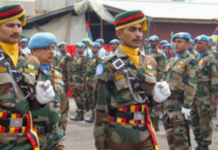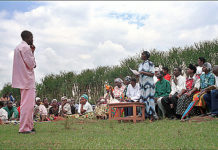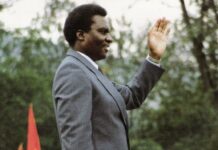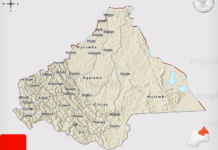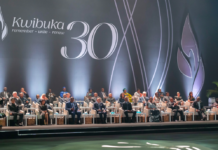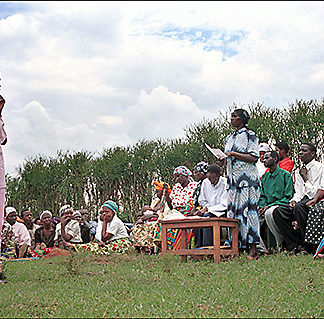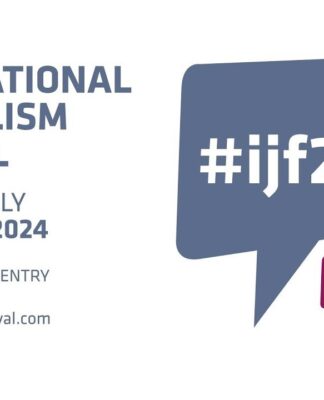While the African Continent has seen no shortage of war in our time, few of these conflicts produced campaigns or battles worthy of study. One exception emerged from the war in the Democratic Republic of the Congo, formerly Zaire, which lasted from 1998 to 2001. This conflict, which has been called Africa’s World War, came to directly involve nine African countries. This war was remarkable in many respects, not the least of which was its opening phase that featured a long range aerial insertion of ground troops behind enemy lines, with the aim of achieving a quick knockout victory. This was an operation that exemplified audacity and courage, and its aftermath became an odyssey fit for a Hollywood script.
This conflict had its origins in the 1996-7 ‘war of liberation’ in Zaire, during which an alliance of Congolese rebels and foreign forces overthrew the country’s dying despot, Mobutu Sese Seko. While the liberation theme was pushed for public consumption, the underlying causes of the war involved efforts by the regimes of Rwanda, Uganda, and Burundi to defeat domestic opposition groups operating from eastern Zaire. Rwanda, with the most serious crisis, was at the center of this effort.[1]
Rwanda sank into a period of civil war in 1994, during which Hutu and Tutsi tribes engaged in a horrific genocide that took the lives of up to 800,000 people. Hundreds of thousands of Rwandans fled to refugee camps in eastern Zaire, among them many Hutu soldiers and militiamen who took part in the massacres. These groups used the camps to reorganize and resume their attacks into Rwanda.[2] By 1996, when Mobutu’s decaying state was unable to deal with the crisis, Kigali’s Tutsi-dominated government determined to solve the problem with its small, but highly disciplined army.
Plucking a rotund, aging Congolese Marxist revolutionary, Laurent-Desiré Kabila, from a comfortable East African exile, the Rwandans set him at the head of an army of liberation consisting of Rwandan ‘advisors’, Zairean dissidents and military deserters, and child soldiers. With Ugandan and Burundian assistance, the alliance swept to power in May of 1997. Kabila set about remaking the country. One of his first acts was to change the country’s name back to its pre-Mobutu appellation of the Democratic Republic of the Congo. For more than a year, Kabila and his Rwandan allies co-existed in power. The Rwandans occupied many key posts in Kabila’s government and the new Congolese Army (FAC).
One of the central figures in the conflict in the Congo was a Rwandan Colonel, James Kabare (also spelled Kabarebe). Kabare, a Tutsi, was born in Rutshuru in eastern Congo in 1959. A long time confidant and aide to Rwandan President Paul Kagame, he came to play a key role in Rwandan foreign affairs. During Kabila’s march across Congo in 1996-7, Kabare served as the rebel leader’s Chief of Operations. Kabila later appointed Kabare to be interim Chief of Staff of the FAC. Kabare, wiry and intense, was hard liner with a ‘never again’ determination to defend Kagame’s regime. An ardent soldier, he claimed to have participated in hundreds of combat operations.[3]
Laurent Kabila was not the puppet the Rwandans expected. He came to resent their control and feared Kigali planned his overthrow. Abruptly, on July 13, 1998, Kabila replaced Kabare as his military Chief of Staff. Two weeks later, he ordered all Rwandan troops to depart the Congo.[4] He then rounded up all ‘counter-revolutionaries’, including Congolese Tutsis (called, Banyamulenge), which he suspect of being pro-Rwandan.
Congo’s king-makers were not so easily dismissed. They decided to replace Kabila. On August 2, 1998, Congolese military units mutinied in Goma, near Congo’s eastern frontier with Rwanda. Soldiers belonging to a new Rwanda-backed rebel group took over a local radio station and announced a revolt to oust Kabila. On cue, Rwandan Patriotic Army (RPA) forces steamed across the border into Goma and Bukavu. As these events unfolded, in Kinshasa several hundred Rwandan soldiers who had evaded Kabila’s repatriation order, and supported by Banyamulenge fighters, attacked FAC army bases. FAC units suppressed these attacks, but were quickly overwhelmed in the east. Within days, the RPA controlled Congo’s eastern border from Bukavu to Uvira and was moving deep into the Kivu provinces. In northeastern Congo, Ugandan Army (UPDF) forces invaded Ituri District and began their drive for Kisangani – Congo’s commercial hub on the upper Congo River.[5]
Laurent Kabila did not panic. The sheer size of his country, the nature of the terrain, and the lack of trafficable roads would doubtless slow the enemy. The year before, it had taken his forces months to march across Congo, and in the face of little resistance. Surely, he would have the time to assemble forces and international support to stem the tide.
The Rwandans and their Ugandan allies would deny him that luxury. They realized that they needed a quick blow to hasten the end of this war. They had little regard for Congolese forces, but feared a long campaign and the grueling march across the tangled terrain of dense forests, marshes, and innumerable rivers of the Congo River basin. Plus, a quick strike would minimize international condemnation and the risk of drawing neighboring countries into the fight.
The Rwandans conceived a bold plan: As the offensive in the east developed, they would airlift a contingent of troops 1,500 kilometers across the Congo basin to Kitona air base, located 320 kilometers west of Kinshasa near the Atlantic coast. From there, the contingent would march east, capturing key infrastructure, and attack Kinshasa from the rear. Along the way, they hoped to augment their numbers with Congolese deserters and dissidents, and by liberating Banyamulenge rounded up by Kabila. A Rwandan ‘fifth column’ was already at work in the ghettos of Kinshasa, distributing arms and bribing indigent youths to act as guides within the city.[6] The Rwandans hoped to generate a popular revolt against the Kabila regime. Failing that, at the very least they would sow chaos.
The Rwandan plan targeted Congo’s economic umbilical, the Bas Congo province. Located west of Kinshasa, this province formed the finger of land that linked Congo’s vast interior with its tiny, 43-km coastline. While Congo’s smallest province, it strategically the most important, containing its only known oil reserves and its primary source of electrical power, the Inga dam complex. This latter facility powered much of Congo, from Kinshasa to the mining cities of Katanga province, 1,700 kilometers distant. Congo’s only oceanic ports were there, including the port of Matadi, and an oil pipeline and rail line linking Kinshasa to the ocean.[7]
It was an audacious plan, and one fraught with risk. This small force would be required to push across more than 300 kilometers of difficult terrain, seizing several intermediate objectives along the march, at the end of which it would attempt to invest and occupy a city of some 6 million people. The logistics of the operation would depend on a long, tenuous air bridge. The Rwandans did not fear privations or their adversary. They counted on the psychological impact of the operation. Surprise, and their network of agents in Kinshasa, would ensure panic and the collapse of any organized resistance.
If the Rwandans feared anything, it was Angola. Geography loomed over the Kitona operation. The Angolan frontier lay just south of the air base; to the immediate north was the Angolan enclave of Cabinda. Angola had already shown itself willing to act unilaterally to stabilize the region. The year before, the Angolan Army had intervened to end a civil war in Congo-Brazzaville and its troops were stationed in that country. Moreover, the Angolan Army was a formidable force. Its 112,000 soldiers outnumbered the combined forces of Rwanda, Uganda, and the Congolese rebels.[8] Angolan soldiers were hardened by more than two decades of civil war. In short, the entire adventure depended on Angolan neutrality.
On August 3, as RPA units were still consolidating their foothold in eastern Congo, Rwandan forces under the personal command of Colonel Kabare, now Rwandan Army Deputy Chief of Staff, commandeered three civilian airliners at Goma’s airport. The following day, he embarked 500 Rwandan soldiers and a Ugandan artillery unit and headed for Kitona.
The contingent landed at Kitona air base on the morning of August 4, 1998. The defenders offered little resistance. Most were ex-Zairean soldiers who had been sent there for re-training. Unpaid for several weeks, the sight of bundles of U.S. dollars the Rwandans brought drew many to the ranks of the contingent. The Rwandans captured nearby Muanda and Congo’s petroleum operations. In subsequent days, additional flights from Goma and Kigali brought another 3,000 RPA and Congolese rebel soldiers. The contingent began its march east. Boma and Buama fell in rapid succession. By August 13, the invaders had captured Matadi and the Inga damn complex, the last of their intermediate objectives, and stood halfway to their prize. The Rwandans ordered Inga’s turbines shut down, plunging Kinshasa and much of Congo into darkness.[9]
Laurent Kabila moved to his provincial refuge at Lubumbashi, where he worked feverishly to assemble support for his tottering regime. He lobbied the Southern African Development Community (SADC) for military assistance. On August 17, three key members of that body – Zimbabwe, Angola, and Namibia – gave him their support. Zimbabwean troops began to arrive in Kinshasa shortly thereafter. Angola remained on the sidelines. South African President Nelson Mandela, then also SADC President, called an emergency meeting of its members for August 22.
The contingent marched on, silently now, for resistance had dissolved. Villages emptied before them. Weapons shouldered, the soldiers filed along the undulating banks of the Congo River, moving ever closer to Kinshasa and the gray waters of the Stanley Pool. Panic engulfed the city, as thousands tried to flee across the river to Brazzaville. The government closed the ferry and people retreated to the ghettos. Diplomats and foreign workers flooded the airport. On August 22, the day the summit was schedule to occur, the Rwandans and their allies were 30 kilometers west of Kinshasa. In the east, Rwanda and Ugandan forces were more than 150 kilometers inside Congo and pushing west under little resistance.[10] It was a race against time, and the Rwandans appeared to be winning.
Then, it all fell apart. Mandela’s summit failed to come together. Despite his efforts, Angola and Namibia were preparing to intervene in the war. On 23 August, Angolan President José Eduardo Dos Santos announced that his troops would defend Kinshasa. They had in fact already entered Congolese territory. That day, 2,500 Angolan troops, supported by tanks and fighter aircraft, attacked the Rwandan rear base at Kitona. Overwhelmed, the Rwandans rear guard dispersed. Feeling somewhat reassured, Kabila returned to Kinshasa. The hunter now became the hunted. Their line of retreat severed, Colonel Kabare and his commanders had little choice but to press on to Kinshasa. Two days later the contingent began working its way into the hills that surrounded the capital.
The fight for Kinshasa began in the early morning hours of August 26, 1998. It lasted for three days. The Rwandans surrounded the city and infiltrated key areas, probing for weaknesses. Their attacks were concentrated against the Kasangulu township at western approach to Kinshasa and N’djili airport in the east. These efforts failed, largely due to the stout resistance of Zimbabwean troops. The Rwandans also failed to generate a popular rising in the urban quarters. Rumors of a Tutsi uprising launched a spontaneous vigilante hunt for Banyamulenge and collaborators. In those frenzied days, dozens were lynched and the streets smoked with the charred bodies of those burned alive.[11]
The Rwandans and their allies pulled back into the hills, where they regrouped and took stock of their plight. They were dangerously short of supplies, their line of retreat was cut, and they were more than a thousand kilometers inside hostile country. FAC and Angolan troops were converging on them from east and west. One by one, they recaptured Muanda, Boma, Inga, Buama, and Matadi. The contingent had only one choice – exfiltration. But from where? The nearest airfield was north, across the Congo River in Congo-Brazzaville. This was not a viable option, given the lack of barges and that country’s alignment with Angola. Looking over a map, Kabare spotted a small regional airport across the Angolan border at Maquela do Zombo. UNITA rebels roamed this area during the Angolan Civil War and it remained largely uncontrolled by Luanda.
As the main body hunkered down and licked its wounds, the Rwandans hastened a reconnaissance team to Maquela do Zombo to determine the suitability of the airport. The team returned a week later, haggard and parched by the height of the African summer. The news was not good: The airport was occupied by 400 Angolan troops. Undeterred, the Rwandans began to plan for an attack on the airport.
In mid-September 1998, Colonel Kabare was ready to make his move. Leaving behind the sick and wounded, he took the contingent across the border and marched on Maquela do Zombo. Arriving several days later, they launched a night attack that surprised and routed the defenders. Over the following days, Kabare had the sick and wounded brought to the new camp, while his forces prepared defenses around the airport. Inspecting their prize, they found that the runway would need improvements. They would need to extend the length of the runway from 1,400 to 1,800 meters to allow for larger cargo planes to land. Runway lights would be required for a night time evacuation. Kabare realized he would need time. He pushed forward their defenses and blocked the only access road 100 kilometers from town.
For nearly two months the contingent held the airport against encroaching Angolan forces. They repelled several Angolan attacks, including one spearheaded by 26 armored vehicles. Small supply flights arrived from Rwanda, bringing the tools and generators that enabled them to add extend the runway and add lights. With the runway ready, aircraft began arriving to evacuate the contingent to Kigali. Over the next few days, the Rwandans made more than 30 flights out of Maquela do Zombo. Kabare later remarked, “As we emptied the airport, we fell back from the perimeters. On the last day, our defenses were just a few kilometers from the airport.” On the final night of the operation, the Rwandan rear guard and the commanders made a dash for the last plane as the Angolans closed in.
By Christmas Day, 1998, the last elements of the contingent returned home. Thirty-one soldiers of the Ugandan artillery unit, healthy and smiling, debarked to a heroes’ welcome at Kampala. Major General Afande Saleh, the Ugandan Minister of Defense, was on hand to greet them. Kabare later noted with satisfaction, “We handed them all in good health to Afande Saleh.” He paused, allowing himself a rare degree of sentiment, “They were all really good boys, some of the best.”
The intervention of SADC forces saved Kabila’s regime. After the Rwandans were turned back at Kinshasa, the war in the Congo settled into a stalemate that lasted more than two years. In January, 2001, a bodyguard assassinated Laurent Kabila and his son, Joseph Kabila, replaced him. By then, war fatigue chased off many of the belligerents, and those few remaining bowed to pressure to end a conflict that had become increasingly indefensible and unpopular. Congolese government and rebel leaders signed a peace agreement and formed a transitional government. In 2006 Congolese went to the polls in the country’s first free elections in 40 years and elected Joseph Kabila president of a unified Congo.
About the author:
Comer Plummer is a retired US Army Officer. He served from 1983 to 2004 as both an armor officer and Middle East/Africa Foreign Area Officer. He is currently employed as a DoD civilian and living in Maryland with his wife and son.



